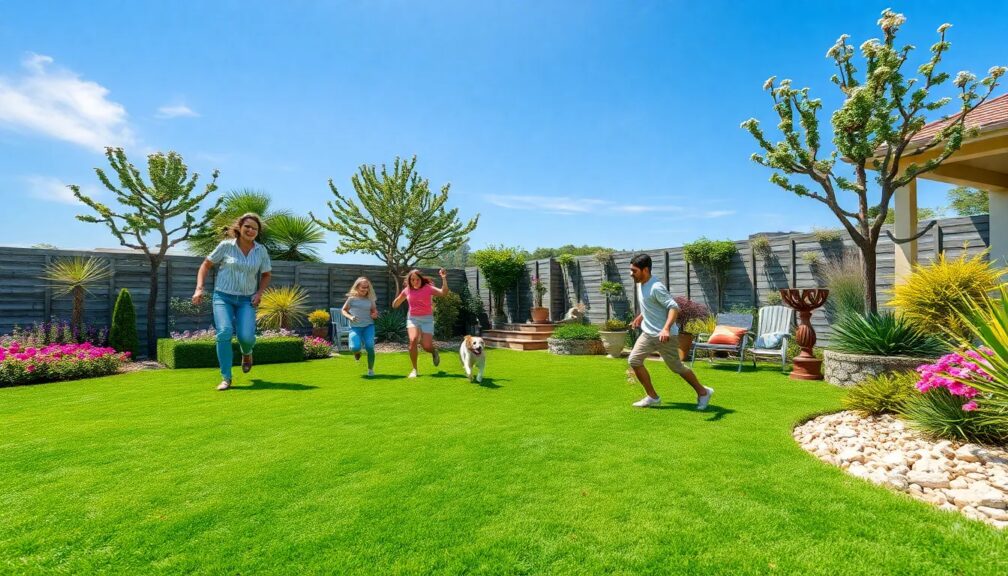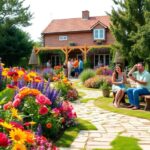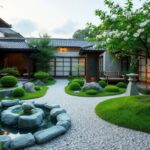Why everyone is ditching traditional grass

In recent years, there has been a significant shift in landscaping preferences as homeowners and businesses alike are moving away from traditional grass lawns. Concerns over environmental sustainability, maintenance efforts, and financial costs are driving this change. This article delves into the reasons behind this trend and explores the alternatives that are gaining popularity. From synthetic turf to xeriscaping, we will investigate how these options are not only more eco-friendly but also offer practical benefits. Whether you're looking to reduce your water usage or simply searching for a low-maintenance solution, join us in discovering why traditional grass is becoming a thing of the past.
Are lawns becoming less popular?
Imagine stepping outside to the familiar sight of a green, manicured expanse—the classic suburban lawn. This iconic scene, however, is undergoing a revolution. As social values shift and environmental awareness grows, the traditional lawn is no longer the default landscape choice for many homeowners. But why the change, and what's driving homeowners to reconsider their grassy greens?
First, let's consider water usage. In regions afflicted by drought, such as California, the environmental cost of maintaining a lush lawn is simply too high. This fact alone has sparked curiosity and led to a surge in alternative landscaping known as xeriscaping, which drastically reduces the need for irrigation.
Moreover, the upkeep of a typical lawn demands not only water but also time and effort. Busy lifestyles mean fewer people have the leisure—or desire—to mow, fertilize, and tend to grass regularly. The appeal of low-maintenance gardens is growing, with many seeking out native plants, wildflowers, and even artificial turf to reclaim their weekends.
But it's not just about convenience or conservation. There's a burgeoning movement towards ecological responsibility. Lawns, it turns out, offer little in the way of habitat for wildlife. In contrast, gardens with diverse plants can support bees, butterflies, birds, and more, contributing to biodiversity.
The aesthetic is changing, too. The uniformity of a lawn is being replaced by the vibrant textures and colors of a more natural landscape. People are waking up to the fact that their yard doesn't have to look like a golf course to be beautiful—it can be a dynamic ecosystem.
As you read this, consider the possibilities of transforming your own outdoor space. Could you be part of this green revolution? Is the perfect, manicured lawn truly perfect, or is it a relic of the past, soon to be replaced by something more sustainable, more interesting, and more alive? The answer might just lie in the growing number of front yards where grass is giving way to garden beds, and the chorus of lawn mowers is fading into the buzz of pollinators at work. Don't let your yard be left behind. The trend is clear: the era of the traditional lawn may be coming to an end, but what will take its place promises to be far more exciting.
Why should we get rid of lawns?
Imagine uncovering a secret that has been hiding in plain sight, right in our own backyards. The traditional lawn, a hallmark of suburban neighborhoods, is due for a revolutionary overhaul, and the reasons are as compelling as they are urgent.
Firstly, consider the environmental impact. Lawns may seem harmless, but they are actually ecological deserts. The typical grassy expanse supports little biodiversity, and its upkeep demands an astonishing amount of water—a resource that is becoming increasingly scarce.
Moreover, the maintenance of these green carpets involves a heavy reliance on chemical fertilizers and pesticides. These substances can have detrimental effects on local wildlife and can even seep into our water supply, posing a risk to human health.
But the true wake-up call comes when we delve into the world of carbon emissions. Gas-powered lawn mowers, trimmers, and blowers contribute significantly to air pollution, something we are becoming more conscious of with each passing day as we grapple with climate change.
And then there's the question of time. The hours spent mowing, watering, and tending to a lawn are hours not spent enjoying leisure, family, or pursuing other more productive and enjoyable activities. Imagine what you could do with all that extra time and freedom.
So what lies beyond the picket fence? The alternatives to traditional lawns are not only environmentally friendly but can also be stunningly beautiful and attract a variety of birds, insects, and wildlife. From native gardens to vegetable plots, the possibilities are both thrilling and endless.
Intrigued? It's time to peel back the layers of this green veneer and discover the profound benefits of saying goodbye to the lawn as we know it. Ready to be part of the groundbreaking change? Stay tuned, and prepare to transform your own little patch of earth into a vibrant, life-supporting haven.
Why did people start cutting grass?
The history of grass cutting is a tale as old as civilization itself, a story deeply rooted in the very fabric of society. It all began with the domestication of landscapes, an effort to tame the wild, to shape nature to our will. The lush, green lawns we see today are a far cry from their untamed ancestors, and the reasons behind this transformation are as intriguing as they are varied.
From the ancient origins of land management to the modern-day quest for the perfect turf, cutting grass has always been more than just an aesthetic pursuit. It's a practice steeped in the need for practicality and survivability. Picture the medieval castles, where keeping the grass short was a matter of security, a way to spot incoming enemies. Or consider the pastoral scenes of grazing sheep, naturally trimming the grass while providing wool and meat.
As we moved into the era of suburban bliss, the reasons for maintaining a manicured lawn shifted. It became a symbol of social status, a silent yet powerful statement of one's place in the community.
But let's delve deeper into the psychological underpinnings. There's something inherently satisfying about a well-kept lawn. It speaks to our love of control and order, a visual representation of man's triumph over the chaos of nature. Yet, the rise of the perfectly trimmed grass blade is not just a matter of vanity; it has sparked an entire industry dedicated to lawn care, with innovations and environmental considerations that continue to shape our approach to this ancient practice.
Imagine the secrets that lie in the evolution of grass cutting, the hidden dynamics that turned a simple act of survival into a cultural phenomenon. There's a world of knowledge waiting to be uncovered, a history that reveals much about our ancestors and, intriguingly, about ourselves. The story doesn't end here; in fact, it's just beginning to get interesting. Don't miss the chance to discover the compelling reasons behind this ubiquitous, yet often overlooked, aspect of our daily lives.
Why is the grass not green anymore?
Discover the Unseen Shifts in Our Environment
In a world where the verdant lawns once symbolized vitality, a mysterious transformation is underway. Imagine stepping outside, expecting to be greeted by the lush, green blades that have become synonymous with a healthy ecosystem, only to find a palette of unexpected hues. This enigmatic change has sparked a global conversation, igniting a quest for answers among experts and amateurs alike.
- Climate Anomalies: Have you considered how shifting weather patterns influence our natural landscapes? As you delve deeper, you'll uncover the intricate dance between climate and chlorophyll that dictates the color of our grass.
- Ecosystem Disruption: Beyond the climate, there are hidden forces at work. Learn about the interplay of species and how introducing or removing a single element can cascade into a wave of color change.
- Chemical Reactions: Sometimes the causes are microscopic. A single chemical reaction can alter the very essence of grass, turning the familiar into the foreign. What could be driving these reactions? Only those who continue the journey will find out.
- Human Influence: Our footprint on this planet is colossal. It's time to explore how our actions, from the agricultural practices to urban developments, have unintentionally painted a new picture of the world we thought we knew.
Unlock the Secrets
The quest to solve this riddle is more than an exploration of color; it's a pursuit of knowledge that could redefine our relationship with the planet. The stakes are high, and the implications are profound. As you seek the truth, remember that what you uncover might not only dazzle the eye but also challenge the mind and stir the soul.
Are you ready to discover why the grass is not the green we remember? The answers lie just beyond the horizon, and the time to act is now. Don't let this chance slip through your fingers; the Earth is speaking to us, and it's time to listen.
Why everyone is ditching traditional grass reddit
The shift away from conventional lawns has become a hot topic, sparking lively discussions across various online communities, including Reddit. As homeowners and landscapers search for sustainable alternatives, the traditional grass lawn is being scrutinized for its environmental impact, maintenance demands, and long-term costs.
Key reasons for this trend include:
1. Environmental Concerns: The typical lawn requires significant amounts of water, contributing to resource depletion. Moreover, the use of fertilizers and pesticides has raised alarms about soil and water pollution.
2. Maintenance Hassles: The time and effort needed to keep a grass lawn lush and green can be overwhelming. Mowing, weeding, and re-seeding are just a few of the relentless tasks that come with traditional turf management.
3. Financial Implications: The cumulative cost of watering, lawn care equipment, and garden services can strain household budgets, pushing individuals to consider more cost-effective ground cover solutions.
In response, pioneering gardeners and eco-conscious individuals are exploring diverse alternatives that offer both aesthetic appeal and environmental benefits. These options range from xeriscaping and native plant gardens to synthetic turf and permaculture designs. Each alternative brings a unique set of advantages that align with the growing desire for low-impact living.
Reddit threads buzz with personal success stories and transformative yard makeovers, creating a sense of Fear of Missing Out (FOMO) among readers. The community shares tips, tricks, and inspirational before-and-after photos that can make anyone eager to jump on the bandwagon.
The result is a vibrant online movement, with participants keen to showcase their eco-friendly paradises and encourage others to rethink the green carpet that has long defined suburban landscapes. Whether it's the allure of a biodiverse habitat or the promise of reduced maintenance, the conversation about lawn alternatives is only gaining momentum.
Are you intrigued by the prospect of ditching traditional grass for something more sustainable? The shift isn't just a fad; it's a reflection of a growing environmental consciousness and a desire for practical living solutions. Don't miss out on this transformative journey—join the discussion and discover how your own space could flourish with these innovative landscaping ideas.
Consejo final: Si estás considerando alternativas al césped tradicional por razones ambientales, de mantenimiento o estéticas, investiga opciones como jardines de césped nativo, plantas de bajo mantenimiento, pavimentos permeables o césped artificial. Evalúa los pros y contras de cada opción en relación con tu clima local, el uso del espacio y las preferencias personales. Sea cual sea tu elección, asegúrate de que se alinea con tus objetivos de sostenibilidad y facilidad de cuidado.
Esperamos que encuentres la solución perfecta para tu espacio al aire libre. Que tu jardín florezca con éxito y sostenibilidad.
 What this landscaper found buried in his backyard will shock you
What this landscaper found buried in his backyard will shock you Nobody talks about this plant… but everyone wants it
Nobody talks about this plant… but everyone wants it The one detail in luxury gardens that changes everything
The one detail in luxury gardens that changes everything What if your garden got more compliments than your house?
What if your garden got more compliments than your house? This is what happens when you add Japanese design to your yard
This is what happens when you add Japanese design to your yardIf you want to know more about similar articles like Why everyone is ditching traditional grass you can visit category Landscaping.
Deja una respuesta